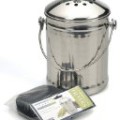From my research, it seems that there are as many different methods for composting as there are types of tomatoes to grow.
All composting methods are classified based on the temperature at which the pile works. The hotter the pile, the shorter it takes for it to be finished. There are hot methods where the soil is done is as little as 6 days. There are drawbacks to a hot pile, though.
The theory is that the hotter temperatures kill desirable microbes, like fungi, that improve the health and quality of the end product. These fungi help to combat diseases, so killing them makes the soil less disease resistant. The other drawback, though I’m sure there are more, is that it takes way more work to keep a pile hot. Aeration is what keeps the temperature up, and the main way you keep it aerated is by turning the pile. I happen to have a tractor, so this will not be much of a damper on my effort.
Hot Composting Advantages:
- Quick: some hot methods take only days to complete
- Uses space efficiently
- Builds soil fertility for new garden locations
- Kills most weed seeds
- Kills most disease in yard wastes
Hot Composting Disadvantages:
- takes the most work
- Must control ratio of Carbon to Nitrogen carefully
- You build these piles all at once, so you have to collect and store your wastes, instead of adding them gradually
- Nitrogen gets used up in the decomposition process, so there’s less left in the final humus
- Hot-made humus has less ability to fight soil-borne diseases
Hot Composting Methods:
- California Method
- City People’s Method
- Compost Tumblers
- Raised Bins (warm)
Cold piles take way less work. Just pile on the stuff and you wait. The drawback to a cold pile is that since they are not aerated, they tend to be on the stinky side, unless you can cover them up with soil. The main drawback, though, is the time it takes to complete. I am also not in favor of cold methods, since they do not kill weed seeds nor disease that may be in the yard waste that I add to the pile.
Cold Composting Advantages:
- Very low maintenance
- End result humus has an immunity to more soil-borne diseases
- More Nitrogen is left in the humus
- Pile can be built gradually, not all at once
Cold Composting Disadvantages:
- Takes from 6 months to 2 years for finished humus
- Does not kill weed seeds
- Does not kill disease in yard waste
- Not as efficient at composting the high-carbon materials
- Nutrients get lost through time and exposure to the elements
- Can get stinky, if not turned or covered
Cold Composting Methods:
- Indore Method
- Ogden’s Step-by-Step Composting
- Pit Composting
- Mulch and Sheet Composting
- Trench and Posthole Composting
- Anaerobic Composting
Methods that can be made hot or cool:
- Movable Compost Bins
- Windrows & Piles
- Biodynamic Composting


